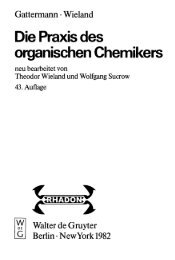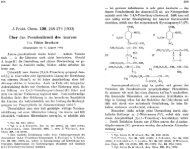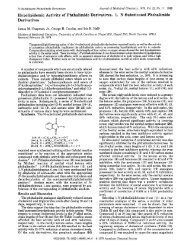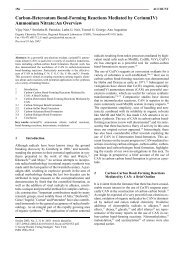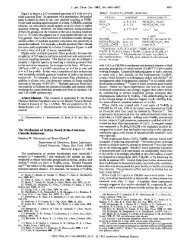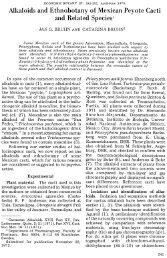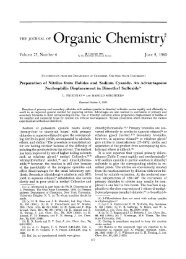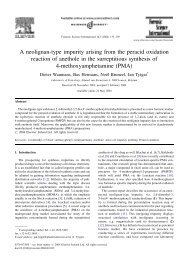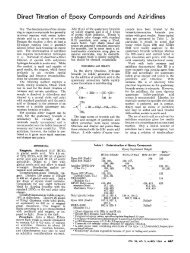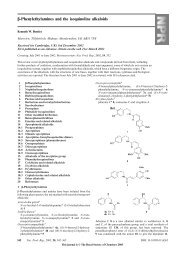Create successful ePaper yourself
Turn your PDF publications into a flip-book with our unique Google optimized e-Paper software.
11<strong>28</strong> NOTES <strong>VOL</strong>. <strong>28</strong>NotesChlorination of Ketones with SeleniumOxychlorideJOHN P. SCHAEFER AND FRED SONNENBERGDepartment of Chemistry, University of Arizona, Tucson,ArizonaReceived h'overnber d, 1962Seleniuni(1V) compounds are noteworthy for theirspecific ability to oxidize activated methylene groupsin organic compounds. In recent years we have beenconcerned with the mechanism' and scope of thesereactions and have found, for example, that oxidationof an a-halo ketone with selenium dioxide in an alcoholicsolvent can provide an efficient route to a-keto esters.2As a result of subsequent studies with related compoundswe have found that selenium oxychloride (I)can be used as a reagent for the preparation of a-chloroketones. When a ketone containing an a-methylenegroup is mixed with I in an inert solvent (benzene, ether)a rapid exothermic reaction takes place with theformation of a dichloroorganoselenium compound.3-5Decomposition of this intermediate by heating at itsboiling point or by refluxing in benzene for several hoursresults in the precipitation of selenium and formation ofthe corresponding a-chloro ketone. Over-all yields areof the order of 50%.- HrO2RCOCHa + SeOC12 + [RCOCHzlz SeC12 --f2RCOCHzC1 + SeThe following list summarizes some typical results.acetophenone a-chloroacetophenone (54%)cyclohexanone + a-chlorocyclohexanone (41 Vo)pinacolone --+ a-chloropinacolone (46Yo)p-bromoacetophenone +a-chloro-p-bromoacetophenone ( 58%)propiophenone --+ a-chloropropiophenone (42%).Yields are based on purified. distilled compounds andproducts were identified by physical constants, infraredspectrum, positive chlorine test, and, in most cases, asolid derivative.For synthetic purposes it is unnecessary to isolate theorganoselenium intermediate and we have found itconvenient to prepare and decompose the adduct inthe same flask, using benzene as the solvent. Furtherwork is in progress attempting to extend this reactionto include other halogens and active methylene compounds.(1) E. J. Corey and J. P. Rchaefer. J. Am. Chen. Sac., 82, 918 (1960);J. P. Schaefer. ibid., 84, 713, 717 (1962).(2) J. P. Schaefer and E. J. Corey, J. Ore. Chem., 24, 1825 (1959).(3) R. E. Nelson and R. N. Jones. J. Am. Chem. SOC., 63, 1588 (1930).(4) The same adduct is reported to be formed with selenium tetraohl~ride.~(5) A. Michaelis, Be?.. 30, <strong>28</strong>21 (1897); A. Michaelis and F. Kunckell,ibzd., 30, <strong>28</strong>23 (1897).ExperimentalAll of the reactions reported above were carried out under similarexperimental conditions. The most convenient procedure isdescribed below for the conversion of acetophenone to CY-chloroacetophenone.or-Ch1oroacetophenone.-In a 200-ml. round-bottom flaek wasplaced 100 ml. of benzene and 2 g. (0.2 mole) of acetophenone.The flask was cooled in an ice bath and 16.6 g. (0.1 mole) ofselenium oxychloride was slowly added, cooling the flask aa necessary.After allowing the solution to stand at room temperaturefor about 1 hr., precipitation of the organoselenium adduct wasessentially complete. The flask was then equipped for distillationand all of the benzene removed. The crystalline mass washeated with a free flame and the a-chloroacetophenone collectedalong with other pyrolysis products. Redistillation gave 16.7 g.(547,) of pure a-chloroacetophenone b.p.139-140' (14 mm.).The Wittig Reaction Using MethylsulfinylCarbanion-Dimethyl Sulfoxide'RICHARD GREENWALD, MICHAEL CHAYEOVSKY, ANDE. J. COREYDepartment of Chemistry, Harvard University,Cambridge 58, MassachusettsReceived December 13, 1966Recently a brief account was given of an efficient andvery convenient procedure for effecting the Wittigreaction.2 In this note examples are presented whichillustrate the utility and merits of this simplifiedmethod. The methylsulfinyl carbanion is first formedfrom dimethyl sulfoxide-sodium hydride (75-80').The solution is cooled and treated with a phosphoniumsalt to yield the alkylidene phosphorane or Wittigreagent almost instantaneously. Subsequent additionof the carbonyl component, and appropriate reactiontemperature, time, and product isolation completethe process.The Rittig reaction appears to proceed more rapidlyin dimethyl sulfoxide than in the customary solventsand, further, the yields obtained are frequently superiorThus, the yield of methylenecyclohexane obtained byour procedure is twice that obtained by the OrganicSyntheses method of Wittig.3 Camphor, a ratherunreactive ketone, presents no special problem. Inaddition, these conditions allow highly selective reactionwith the ketonic function of keto esters.The examples presented in the Experimental illustratethe modification in a variety of instanceswhich serve to outline appropriate conditions and isolationprocedures. Lastly, it is worthy of note thatour simplified procedure is excellent for small-scalework. In connection with other synthetic problemsin these Laboratories, a$3 little as 5 mg. of ketone hasbeen converted to olefin in high yield by using careful(1) Research supported by the National Institutes of Health.(2) E. 3. Corey and M. Chaykovaky, J. Am. Chen. SOC., 84, 866 (1962).(3) G. Wittig and U. Schoellkopf, OVQ. Syn., 40, 66 (1960).
API~IL, 1963 SOTES 1129technique and a standardized solution of methylsulfinylcarbanion.ExperimentalMethylenetriphenylphosphorane. General Procedure.-Sodiumhydride (0.10 mole as a 55% dispersion in mineral oil) in a303-ml. three-necked flask was washed with several portions ofn-pentane to remove the mineral oil. The flask then wasequipped with rubber stopples, a reflux condenser fitted with athree-way stopcock, and a magnetic stirrer. The system wasalternately evacuat'ed and filled with nitrogen; 50 ml. of dimethylsulfoxide was introduced via syringe, and the mixturewas heated at 75-80' for ca. 45 rnin., or until the evolution ofhydrogen ceased. The resulting solution of methylsulfinylcarbanion2 was cooled in an ice-water bath, and 35.7 g. (0.10mole) of methyltriphenylphosphonium bromide3 in 100 ml. ofwarm dimethyl sulfoxide was added. The resulting dark redsolution of the ylide was stirred at room temperature for 10 min.before use.Methylenecyclohexane.-Freshly distilled cyclohexanone, 10.8g. (0.11 mole), was added to 0.10 mole of methylenetriphenylphosphorane,and the reaction mixture was stirred at roomtemperature for 30 min. followed immediately by distillationunder reduced pressure to give 8.10 g. (86.37,) of methylenecyclohexane,b.p. 42' (105 mm.) which was collected in a DryIce trap. [lit.,3 b.p. 99-101" (740 mm.)].Methoxymethylenecyc1ohexane.-To a solution of 0.02 moleof methoxyrnethylenetriphenylphosphorane was added 1.96g. (0.02 mole) of cyclohexanone, and the mixture was stirred for1 hr. at room temperature. The resulting mixture was thendistilled under reduced pressure; the fraction of b.p. 70-80"(30-35 mm.) was collected in a flask cooled at -20", washed withaq.lueous potassium carbonate, extracted with n-pentane, anddried over anhydrous magnesium sulfate. Removal of thepentane and distillation of the residual oil gave 1.70 g. (67.6YG)of meth~xyrnethylenecyclohexane, b.p. 70-71' (37 mm.).4The infrared spectrum showed bands at 5.90 and 11.10 g.2-Methylenebornane.-( +)-Camphor, 6.08 g. (0.04 mole),in 20 ml. of dimethyl sulfoxide was added to a solution of 0.05mole of methylenetriphenylphosphorane, and the reactionmixture heated at 50" for 1 hr., at which time 5 ml. of n-pentanewas introduced to wash down any sublimed camphor. Heatingwas continued for 16 hr. at a bath temperature of 56'; the solutionwas cooled and poured into 40 ml. of water Theaqueous phase (containing some precipitated triphenylphosphineoxide) was extracted three times with 100-, 7.5, and 50-ml. portionsof n-pentane, respectively. The triphenylphosphine oxideand dimethyl sulfoxide layer were further extracted with two75-m1. portions of pentane. The pentane fractions were combinedand washed with 100 ml. of a 1:l water-dimethyl sulfoxidesolution, and then with 200 ml. of a 50% saturated sodiumchloride solution. The pentane layer was dried over anhydrousmaqnesium sulfate and passed through 25 g. of neutral alumina(activity 1). The alumina was eluted with pentane until anegative tetranitromethane test was obtained. All eluentswere combined, and the pentane waa distilled using a Vigreuxcolumn. The residual oil was sublimed to give 4.40 g. (73.4%)of 2-.nethylenebornane,6 m.p. 68-70". The infrared spectrumwas in agreement with expectations and with that given by Zeissand Zwanzig5; the n.m.r. spectrum showed three sharp methylpeaks at 0.75, 0.90, and 0.92 p.p.m. downfield from tetramethylsilane,multiplets due to seven protons at 1.0 to 2.5 p.p.m. andtwo olefinic protons as a multiplet with center at ca. 4.6 p.p.m.downfield from tetramethylsilane.3-Methylenecholestane.-A solution of 3-cholestanone, 0.357g. (1.0 mmole), in 5 ml. of tetrahydrofuran (distilled from calciumhydride) was added to a solution of 1.5 mmoles of methylenetriphenylphosphorane,followed immediately by the additionof 20 ml. more of tetrahydrofuran to redissolve any precipitatedcholestanone. The reaction mixture then was stirred at abath temperature of 50" for 22 hr., poured into 150 ml. of water,and the aqueous solution was extracted with 75-, 50-, and 25-mI.portions of n-pentane. The pentane extracts were washed with100 ml. of water, dried over anhydrous magnesium sulfate, and(4) S. G. Levine, J. Am. Chem. Sac., 80, 6150 (1958), reports isolation, in40% yield, of the 2,4-dinitrophenylhydrazone of cyclohexane carboxaldehydefrom this reaction.(5) H. H. Zeiss and F. R. Zwanaig, ibid., 79, 1733 (1957), report the preparationof 5-methylenebornane, m.p. 62.5-64O, by a different route.passed through 5.0 g. of neutral alumina (activity I). Elutionwith pentane and evaporation and recrystallization from methanolgave 0.266 g. (69%) of 3-rnethylenechole~tane,~ m.p.64-65 O.Methyl 4-(p-Anisyl)-4-pentenoate.-To a solution of 0.013mole of methylenetriphenylphospharane was added 2.22 g.(0.10 mole) of methyl 3-p-anisoylpropionate. After keeping atroom temperature for 23 hr., the solution was poured into 250ml. of water and the product was extracted with pentane. Thegreenish yellow pentane extracts were combined, washed with 100ml. of a 1 : 1 water-dimethyl sulfoxide solution and then with 200ml. of water, dried, and filtered through 5 g. of neutral alumina(activity3). Theproduct waseluted with300ml. of pentane, thecolorless eluents combined, and the pentane removed on a steambath. The semisolid remaining was crystallized from methanolwaterat low temperatures. The yield of crude product was 1.77g. (80.5%), m.p. 26-<strong>28</strong>". The infrared spectrum was entirelyfree from the ket80ne absorption at 5.93 p, and showed the characteristicmethylene bands at 3.12 g, 6.12 g (both appeared asshoulders), and 11.12 p. An analytical sample was prepared byevaporative distillation at 0.10 mm., bath temperature, ca. 135".Anai. Calcd. for C13Hl003: C, 70.89; H, 7.32, Found: C,70.70; H, 7.<strong>28</strong>.Spiro( cyclopropane-1 ,g-fluorene).-To a solution of 0.04mole of methylenetriphenylphosphorane was added 1.80 g.(0.01 mole) of 9-fluorenone in 20 ml. of dimethyl sulfoxide. Thereaction mixture was stirred at a bath temperature of 55" for 3days and the resulting deep greenish blue solution was pouredinto 100 ml. of water followed by extraction with 75-, 50-, and25-ml. portions of n-pentane. The yellow pentane extractswere combined, and the total volume reduced to ca. one-fourththe original. An excess of a 307, hydrogen peroxide solutionwas added to the pentane and the heterogeneous mixture stirredfor 3 hr. to ensure the oxidation of all triphenylphosphinepresent. The pentane layer was separated, washed with water,dried, and passed through 15 g. of neutral alumina (activity 1).Elution with pentane was continued until no further solid was obtainedon evaporation of the eluent. Recrystallization frommethanol gave 0.565 g. (29.4%) of spiro(cyc1opropane-l,9-fluorene), m.p. 69-70' (lit.,'m.p. 70-71').1,l-Diphenylpropen-1 .-A solution of sodium methylsulfinylcarbanion was prepared under nitrogen from 0 03 mole of sodiumhydride and 20 ml. of dimethyl sulfoxide. The solution wascooled in a cold water bath and stirred during the addition of11.1 g. (0.03 mole) of ethyl triphenylphosphonium bromidein 60 ml. of dimethyl sulfoxide, whereupon the deep red colorof the ethylidenephosphorane was produced. After stirringat room temperature for 15 min., 4.55 g. (0.025 mole) of benzophenonein 10 ml. of dimethyl sulfoxide was added and stirringcontinued for 3 hr. at room temperature and 1.5 hr. at 60".The reaction mixture was cooled and poured into 200 ml. of coldwater in a round-bottomed flask. The mixture of solid and liquidwas shaken with five 100-ml. portions of pentane which weredecanted, combined and washed once with water, dried overanhydrous sodium sulfate, evaporated to a volume of 50 ml.,and filtered through 30 g. of Merck alumina, wing 11. of pentaneto elute the product. Evaporation of the pentane left 4.73 g.(97.5%) of the product as a white crystalline solid, m.p. 46-49",Recrystallization from 95% ethanol gave colorless plates, m.p.49" (lit.,*m.p. 52'; 46-48").(6) F. Sondheimer and R. hlechoulam, %bid., 79, 5029 (1957).(7) E. Mechoulam and F. Sondheimer, %bad., 80, 4386 (1958).(8) L. Horner, H. Hoffmann, and H. G Wippel, Ber., 91, 61 (1958).Synthesis of TrichloromethylmercuryDerivativesTED J. LOGANThe Proctor & Gawible Company, Miarni Valley Laboratories,Cincinnati 39, OhiaReceived November 63, 1969Two groups of Russian workers recently have reportedthat dichlorocarbene undergoes an insertion



